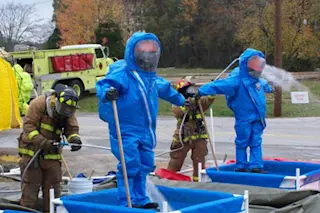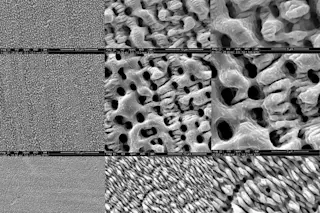Pork and waste. Six years after the fall of the Twin Towers, the devastating blow to the Pentagon, and the inspiring courage of the passengers and crew of United Airlines Flight 93, anti-terrorism funding is an exercise in pork-barrel spending and high-profile projects of dubious value.
On the one hand, we have money being spent on petty projects designed to defend “targets” that are more at risk from a meteor strike than a terrorist attack, like the town of Madisonville, Texas. As reported by The Dallas Morning News, the town, population 4,200, used a federal homeland security grant to purchase a $30,000 customized trailer. The trailer can be used as a mobile command center, but city officials admitted it is more likely to be used as an information and first-aid booth during the town’s annual mushroom festival. Or there’s the story of Dillingham, Alaska, population 2,400. Last year, the Anchorage Daily News noted that Dillingham—which doesn’t have a single street light—had received $202,000 dollars in homeland security funding to purchase surveillance cameras.
On the other hand, the danger of big, headline-grabbing threats has been ameliorated to a limited extent—but these threats, like dirty bombs or bioterrorism, have always been inherently unlikely to come to pass on anything like the apocalyptic scale feared by some.
Ironically, in our effort to thwart terrorists, we’re making things easier for them. Without lifting a finger and starting down the long, difficult, and expensive road of actually making a viable biological, chemical, or nuclear weapon of mass destruction, the terrorists have managed to distract us with the specter of such a device. Meanwhile, we remain vulnerable to other, less dramatic but perhaps much more realistic lines of attack.
Let’s start with dirty bombs, a staple of media-fed fears. In the typical scenario, a group of terrorists steal a few ounces of radioactive material like cobalt 60 from a food irradiation facility. This cannot be used to make a nuclear bomb, but it gives a lethal radiation dose in close quarters. The terrorists wrap the cobalt 60 around a conventional explosive, detonate it, and shower a city with deadly fallout.
To detect dirty bombs in the offing, gamma and other radiation detectors have been deployed to airports and seaports as well as police departments around the country. But there are still many unprotected ports. If drug cartels can regularly sneak tons of narcotics into and around the country, surely terrorists can do the same with a much smaller cache of radioactive material.
What is really keeping us safe is probably not those radiation detectors but the basic physics of trying to carry out a radioactive attack. In order to contaminate a large area with enough radioactive material to pose a major health hazard, the dirty bomb would have to be packed with so much cobalt 60 (on the order of a few ounces in this case) that the terrorists would die of radiation poisoning within minutes of exposure to their own weapon.
A practical dirty bomb’s main effects would be from fear, not radiation, with both the Department of Homeland Security and the American Institute of Physics predicting few deaths from cancer or radiation poisoning, even in densely populated areas. “The radioactivity released by dirty bombs is not life threatening,” says Angelo Acquista, former medical director of the Office of Emergency Management in New York City and author of The Survival Guide: What to Do in a Biological, Chemical, or Nuclear Emergency. Writing in MIT’s Technology Review, Richard Muller, a senior scientist at the Lawrence Berkeley National Laboratory in California, calculated the radiation exposure—measured in a unit known as the rem—that city residents would receive from a practical dirty bomb. His analysis concluded that no one would receive sufficient radiation to induce radiation illness, let alone death, and that the long-term risk of developing cancer was only fractionally increased.
But with lawmakers and government agencies ratcheting up the rhetoric about dirty bombs in their lobbying for more funding, the average citizen can hardly be blamed for considering dirty bombs a grave threat—a perfect example of well-intentioned efforts that would amplify, not dampen, the impact of a terrorist attack.
Bioterrorism is another overhyped threat. According the Center for Arms Control and Non-Proliferation, based in Washington, D.C., since 2001 federal and state governments have spent $41.5 billion combating bioterrorism, with another $6.8 billion on the way. The money has been spent on things like improving sensors to detect an attack and on building up a stockpile of drugs to combat various pathogens like anthrax. Faced with the prospect of terrorists releasing a bioweapon that spawns a deadly nationwide epidemic, quickly overwhelming hospitals and other health services, surely this seems a reasonable outlay.
As with dirty bombs, the main thing keeping us safe from bioattack is the nature of the weapon itself. The most dangerous and virulent pathogens, like the Ebola virus, kill their victims too quickly, so an infected person is able to spread the disease to only a relatively small number of people before succumbing. According to the Centers for Disease Control and Prevention, Ebola has an incubation period of 2 to 21 days and kills 50 to 90 percent of those infected within two weeks of the onset of symptoms. This produces terrifying but limited and short-lived outbreaks. The second problem terrorists face is how to infect victims with their disease of choice. Aerosolizing the pathogen—so that it can be released and inhaled by a large number of people—is an obvious approach, but this is difficult to do, not least because many infectious agents can’t survive long outside a host.

Anthrax is seen as a particular threat because it occurs in spore form, meaning that it can be transported easily and will remain potent for decades. In principle, inhaling just a couple of spores could spark a fatal infection. More realistically, being exposed to several thousand spores would be required for most people to develop symptoms, but that still amounts to a dose weighing far less than a millionth of an ounce.
It’s no surprise, then, that anthrax was used in the still-unsolved bioterror mailings that occurred in the weeks after 9/11. The attacks sparked frenzied countermeasures among the general public, with people ironing their mail to kill spores and reports of people attempting to obtain personal stockpiles of the antibiotic Cipro. The government set up more elaborate schemes to use electron beams to sterilize mail. Yet despite the mailings’ status as the most sophisticated and deadly series of bioterrorist attacks in the United States to date, just five people were killed and another 17 sickened. Compare this with the average annual death toll of 36,000 Americans from ordinary influenza.
Chemical weapons are a more clearly evident risk: The sarin nerve gas that cultists used to attack the Tokyo subway killed 12 and injured hundreds in 1995. As a consequence, stockpiles of the nerve gas antidote, called Chempacks, have been put in place in cities around America, and detection systems are being developed to warn of an attack and have already been deployed in a few places like Grand Central Terminal in New York City. First responders have also been provided with field supplies of nerve gas antidote, with each ambulance in New York City, for example, carrying 60 Mark I kits, says Neal Richmond, former deputy medical director of the New York Fire Department. Each Mark I kit has two autoinjectors, one containing atropine, which works to counteract the immediate effects of the nerve gas, and the other a drug called 2-PAM, which helps the body clear the nerve gas out of its system.
All that said, for those caught in a chemical attack, the available countermeasures are not exactly reassuring. A chemical weapons attack would be a “mass casualty event,” Richmond warns, meaning that emergency responders would expect to be overwhelmed by the number of sick and dying people. In such an event, the rules for treating victims that most people have come to expect from emergency responders are altered. “You want to use available resources to get the greatest benefit for the greatest number of people instead of focusing all your resources on the sickest people,” Richmond says. Rather than treating the sickest first, rescuers would treat the most likely to survive first, evacuating those who can walk or crawl to a decontamination area before sorting out the rest.
In a chemical attack, the task of first responders would be further complicated by their bulky protective suits. These make normal medical examinations impossible, forcing responders to rely on “noxious stimulus triage”—nicknamed kick triage—to sort out the living from the dead. “You don’t really kick them, but you do shake them, move them” to see if they react, says Richmond. “Anyone who doesn’t appear dead gets dragged out” and injected with three Mark I kits. If that stabilizes the victim long enough to reach hospital care, chances are he will survive, as more antidote can be administered as needed to keep counteracting the nerve gas. If the victim’s condition worsens before he can reach the hospital, however, he is unlikely to receive any additional antidote—especially if the antidote is in short supply—as the responders turn their attention to others.
Richmond worries that despite all the elaborate planning made by the Department of Homeland Security and others to deal with chemical and biological attacks, mundane but important things aren’t happening—like conducting enough drills to make sure that these plans actually get implemented properly. He also notes that a lot of money has been spent preparing for rare attacks, but emergency rooms around the country already have difficulties coping with routine patients: “We need to tackle building the everyday infrastructure in this country so that it’s working for every patient, every day. Then when the big things come down, we’ll be pretty prepared.”
Another big part of the homeland security boondoggle is the formula used to dole out federal funds. Originally, after 9/11, homeland security funds were distributed according to a formula that first guaranteed each and every state a certain minimum level of funding and then divvied up remaining funds according to the size of state populations. Not surprisingly, the 9/11 Commission was horrified by such a simplistic approach, which gave money to states whether it was needed or not. Consequently, the commission recommended in its 2004 report that funding be based “solely on risks and vulnerabilities, putting New York City and Washington, D.C., at the top of the current list.”
Since then, there have been attempts to reform the formula to distribute funds based on the actual risk posed by terrorists. Unfortunately, these attempts have resulted in sometimes ridiculous results. Last year’s much-derided analysis by the Department of Homeland Security reduced New York City’s homeland security funding by 40 percent to $124 million, concluding that the metropolis contained no national monuments or icons—somehow skipping over the Statue of Liberty, the Empire State Building, the Brooklyn Bridge, and Wall Street, among others. Although some of New York’s funding was eventually restored, the homeland security distribution formula is still far off the mark set by the 9/11 Commission.
And so pork still abounds, prompting Congressmen Anthony Weiner and Jeff Flake to produce a list last March of the most absurd homeland security grants they could find. Standouts included $36,000 to Kentucky in 2005 to prevent terrorists from raising money at state bingo halls; $7,348 worth of bulletproof vests for the police and fire department dogs of Columbus, Ohio, in the same year; and the biggest whopper of them all, $8,000 in 2006 for a Wisconsin fire department’s clown and puppet shows.
The only silver lining is that these absurd preparations are probably not going to be needed. Why? Because terrorists like getting as much bang for their buck as anyone else, which is why conventional explosives, not exotic weapons of mass destruction, will probably continue to be their primary weapon of choice. “The reality is that conventional weapons are easier to manufacture, transport, and detonate,” says Acquista, a point graphically illustrated by the recent propane-based car-bomb attacks in the United Kingdom.
But let’s imagine a worst-case scenario: A particularly advanced terrorist group does manage to set off a dirty bomb, or a bioweapon begins to spread throughout the population. The natural instinct—evacuate—may not be your best option, and in fact most Department of Homeland Security plans do not envision anything like attempting to evacuate an entire city except in the extremely unlikely event of the aftermath of an atomic bomb blast.
Mostly this is because these kinds of attacks are much more limited in their geographic impact than our fear would lead us to believe and also because evacuating cities quickly is very difficult, as was demonstrated by New Orleans and the Hurricane Katrina debacle. Even on 9/11, when the destruction was confined to a small area of Lower Manhattan, it took six to seven hours to evacuate around 400,000 commuters by boat. With the subways out of commission, another 2.5 million Manhattan commuters made their way home as best they could, taking many hours in most cases and clogging bridges and roads.
Should the worst happen, unless your dwelling is in immediate danger, the best advice may be to ignore all the government-fueled drama and stay home, at least temporarily. Following an atomic blast, for example, “after seven days, the radiation goes down about 90 percent,” says Acquista, making evacuation at that time much safer. Acquista recommends sheltering underground in such a circumstance, which allows as much radiation as possible to be blocked by the ground and buildings above. In the event of a chemical attack, though, he recommends staying indoors aboveground, because nerve agents are heavier than air and hence will accumulate in basements. And although the suggestion that citizens keep duct tape and plastic sheeting on hand was much reviled when made in 2003 by then Secretary for Homeland Security Tom Ridge, Acquista believes it would be useful in a chemical attack to seal a refuge with tape and sheeting until the danger passes, because “most chemicals dissipate very rapidly.” Homeland security, it seems, really does begin at home.















